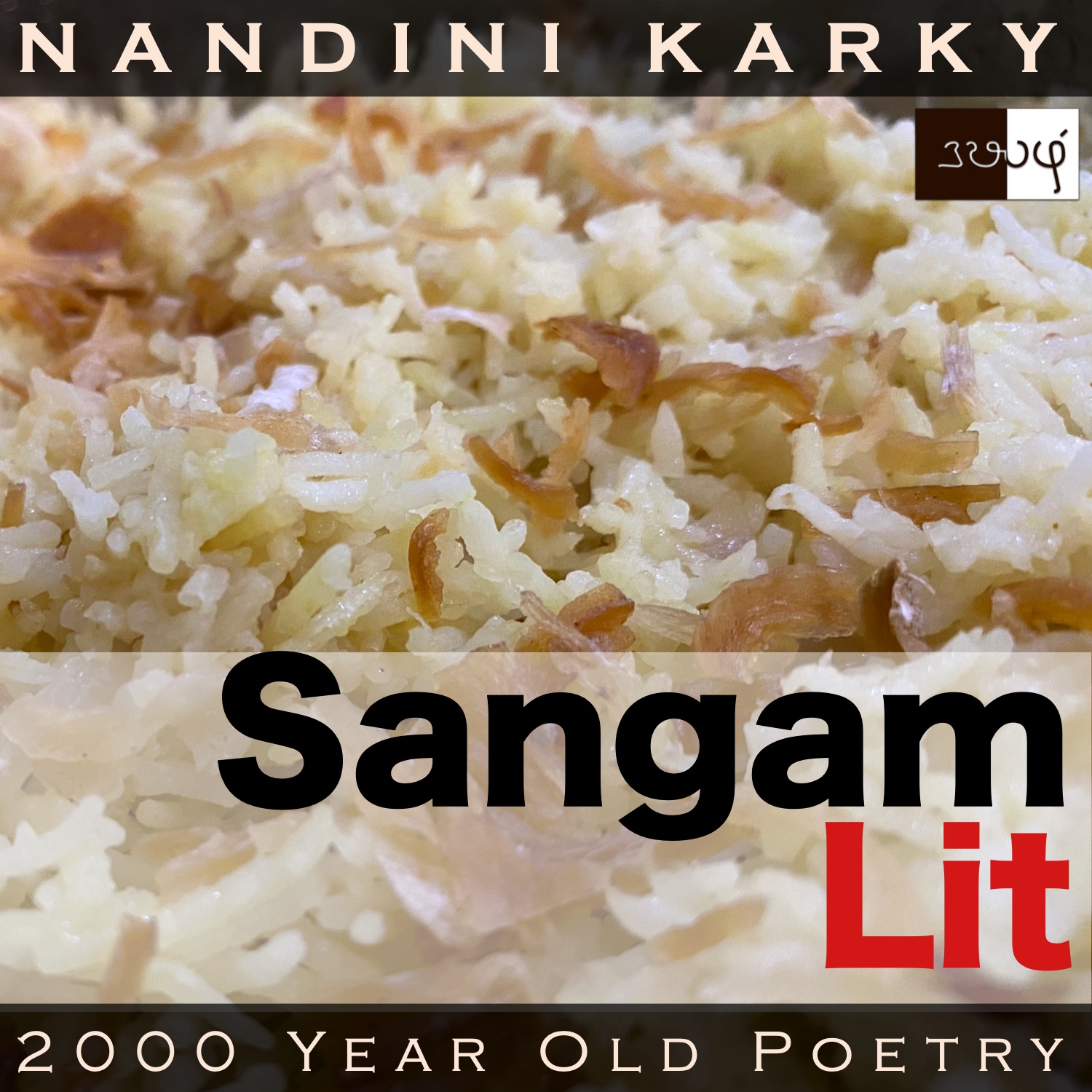Podcast: Play in new window | Download
Subscribe: Apple Podcasts | Spotify | Amazon Music | Android | iHeartRadio | TuneIn | RSS | More

In this episode, we perceive a quaint scene of domestic bliss, as portrayed in Sangam Literary work, Kurunthogai 167, penned by Koodalur Kizhaar. The verse is situated in the forest regions of ‘Mullai’ and speaks in the voice of the lady’s foster-mother to the birth-mother, narrating events that transpired in the lady’s marital home.
முளி தயிர் பிசைந்த காந்தள் மெல் விரல்,
கழுவுறு கலிங்கம், கழாஅது, உடீஇ,
குவளை உண்கண் குய்ப்புகை கழுமத்
தான் துழந்து அட்ட தீம் புளிப் பாகர்
”இனிது” எனக் கணவன் உண்டலின்,
நுண்ணிதின் மகிழ்ந்தன்று ஒண்ணுதல் முகனே.
All about cooking, this one! The verse opens with the words ‘முளி தயிர் பிசைந்த’ meaning ‘kneading well-set curd’ and talks about a well-known food item in Indian cuisine, known as ‘curd’ here, and goes by the alias of ‘yoghurt’ in an international scene, which purists will declare as different. Whatever that may be, here’s an evidence of the usage of curd, known for its probiotic wealth, in Sangam times. Next, we see two comparisons between the lady’s features and flowers – One, in ‘காந்தள் மெல் விரல்’ meaning ‘soft fingers like flame lily’ and the other, ‘குவளை உண்கண்’ meaning ‘kohl-streaked eyes like a water-lily’. Next, the final dish being prepared appears in ‘தீம் புளிப் பாகர்’ meaning ‘sweet and sour gravy’. In ‘கணவன் உண்டலின்’ meaning ‘as the husband ate’, we learn of the lucky diner. Ending with the words ‘ஒண்ணுதல் முகனே’ meaning ‘face with shining forehead’, the verse welcomes us to learn more.
What is really cooking in this verse? The context reveals that the man and lady were newly wed when the lady’s foster-mother came to visit her. After the visit, she returns to the lady’s home and says to the lady’s birth-mother, “After kneading the thick curd with her flame-lily-like, soft fingers, as her well-washed attire slipped away, even without washing her fingers, she touched her attire and wore it. With her blue-lily-like, kohl-streaked eyes, filled with cooking smoke, she served the sweet and sour curry that she stirred on her own to her husband, who savouring it, declared it to be delicious. Hearing that, a subtle joy spread on that face, decked with a luminous forehead.” With these words, the foster-mother passes on the news to the birth-mother that their daughter is leading a happy life with her husband.
As if a mere glimpse of food will satisfy us! Let’s delve deeper and taste every morsel that shines here by listening closely to the foster-mother’s words. Like an expert director, this foster-mother first zooms on to a bowl of thick, well-fermented curd. Next, we observe, the fingers of the lady, described to be as soft as a flame-lily’s petals, near it. Note that the softness means the lady’s fingers have led a protected life and are not used to working at all. Returning, those soft fingers are kneading that thick curd. Just at that moment, the well-washed cloth that the lady wears slips down. Intent on her cooking, the lady uses her curd-streaked fingers to pull it up, and then forgetting all about the stains, she continues, and as time passes, with all the frying and stirring, smoke coats her eyes, the foster-mother narrates. From the kitchen, the scene moves to the dining and here, we see the lady serving her husband this dish she made from curd and which is described by the foster-mother as one, which is both ‘sweet and sour’. Ring any bells? I think the dish the lady cooked up for her husband is a dish prepared even today in Tamil nadu and Kerala and goes by the Tamil name ‘Mor Kuzhambu’. Returning, let’s see what the man says about this labour of love. Showing the good sense of a smart newly-wed husband, he declares the food to be totally delicious. At the moment, the lady hears these words, a soft smile spread on her face, the foster-mother concludes.
What a nuanced way to say that your girl is well and happy! This is a perfect demonstration of a writing advice I keep reading – ‘Show, don’t tell’. It would have hardly taken two lines to convey that the lady has found marital bliss but here, no explicit words are spoken about it, but instead we are taken to that household and shown what that joy really is! No doubt, what the lady did was an unbelievable feat by her in the minds of these mothers, who would still see her as a playful little girl. But now, she’s making intricate dishes and serving it to her husband’s delight. Perhaps, this will make those Sangam mothers conclude indeed their girl has blossomed into a woman. A perfect capture of the emotion a parent feels, when they see their son or daughter, the little ones they had cared for, one day leading a family and doing all the things that goes along with it. It is this timeless awe that echoes from this two-thousand year old verse!




Share your thoughts...